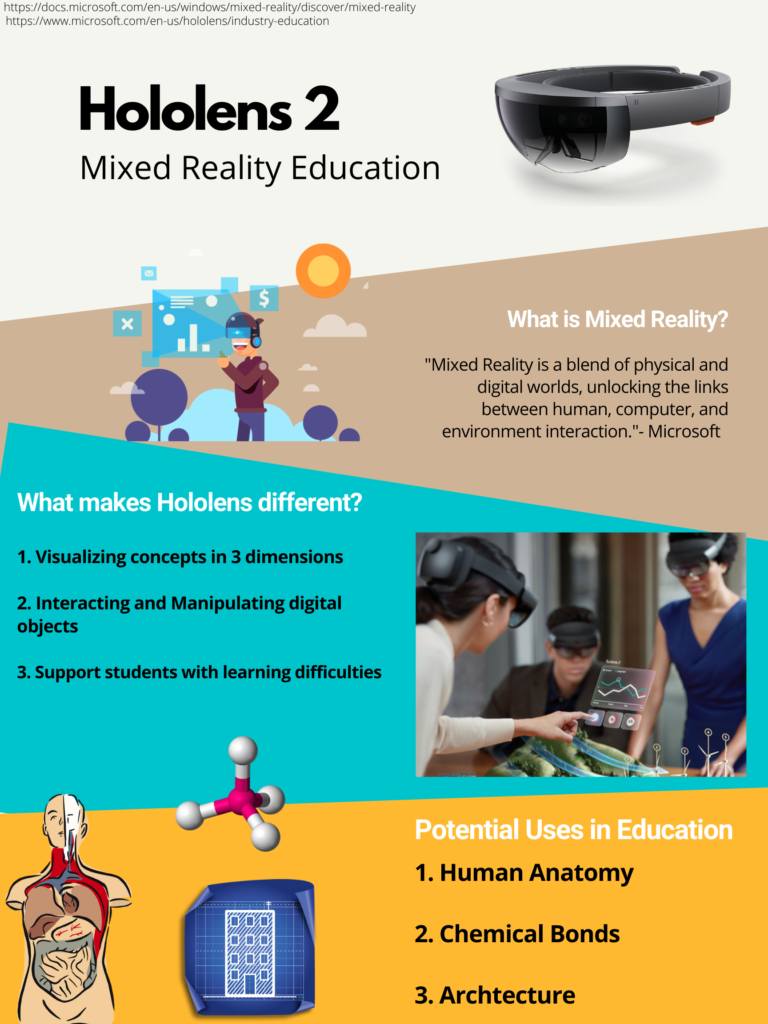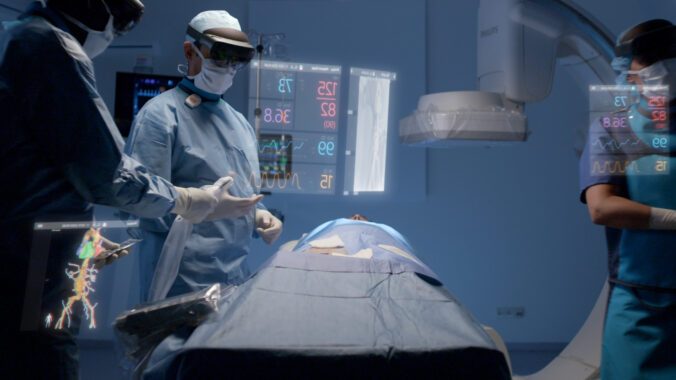Augmented Reality (AR) and education has a massive potential to be used widespread as more smart devices get access to special sensors and lenses to support basic AR applications. AR uses cameras and a device to superimpose an image using the surrounding environment while Virtual Reality (VR) completely recreates an environment on a screen along with fully digital objects (Gupton, 2017). Mixed Reality uses both real world and digital objects and is a combination of VR and AR.
The Microsoft HoloLens 2 is special set of Mixed Reality device that has major potential for both educating medical students and possibly improving quality of care by letting healthcare providers superimpose and manipulate medical imaging such as CT scans to interact with them in an AR space (Philips, 2019). Learning the human body, which is a complex artifact with veins, vessels, bones, and fluids going in a variety of directions could be aided by AR since students can touch (Ideally). Perhaps medical students can also practice going through surgical procedures using the Hololens 2 as a guide instead of having nothing or using cadavers (Philips, 2019). Not only can the Hololens 2 can also potentially help students learn background knowledge of human anatomy, it may also be used to simulate certain scenarios such as emergency responses, telemedicine visits, disaster training, violent patient escalation, patient education and other soft skills that require precise communication in the future (DeCapua, 2018). Although the Hololens seems promising, it is fairly expensive starting at $3500 USD per device (Microsoft Store, n.d).
Although the concept of visual, auditory, and sensory type of learners (OECD, n.d) is a Neuromyth, AR has the potential to stimulate and combine all three types of learning and create an immersive learning environment. Fields trips, and artifacts from historical landmarks around the world could be studied. Overall, I think AR and VR have tremendous potential value, and will be more accessible as smart devices get more computationally capable, and affordable. Here is a poster I made on Canva promoting the Hololens 2.

References
DeCapua, M. (2018, April 24). 7 Ways Microsoft Hololens Will Transform Healthcare. https://www.melissadecapua.com/7-ways-microsoft-hololens-will-transform-healthcare/.
Gupton, N. (2017, September 21). What’s the Difference Between AR, VR, and MR? The Franklin Institute. https://www.fi.edu/difference-between-ar-vr-and-mr.
Microsoft Store. (n.d.). HoloLens 2: Find Specs and Features – Microsoft HoloLens 2. Microsoft Store. https://www.microsoft.com/en-us/p/holoLens-2/91pnzzznzwcp/?activetab=pivot%3Aoverviewtab.
OECD. (n.d.) Neuromyth 3. OECD.
https://www.oecd.org/education/ceri/neuromyth3.htm
Philips. (2019, March 13). Philips and Microsoft HoloLens 2: could augmented reality change the face of image guided therapy? Philips. https://www.philips.com/a-w/about/news/archive/standard/news/articles/2019/20190313-philips-and-microsoft-hololens-2-could-augmented-reality-change-the-face-of-image-guided-therapy.html.

Hello Neil, thanks again for sharing your thoughts and ideas for this weeks forum post. I liked the design of your poster, which I felt covered both the AR/VR topic of this week’s topic, as well as including appealing design principles. The text was clear and visuals easily spaced or organized throughout the poster. Mixed reality is an interesting topic as it combines aspects of both AR and VR, making it a learning technology that potentially has the benefits of both technologies (though I suppose that a device such as the Hololens 2 would be capable of supporting both AR and VR too). Alternating between AR, VR, and Mixed views are likely for headset or app technologies in the future. With the advent of newer technologies and efficiency, perhaps all three technologies would be common in educational settings. Thanks again for sharing your thoughts!
Hi Neil, thank you for sharing your thoughts on the use of AR in the field of education. Through reading your blog post and your infographic, I learned a lot regarding the Microsoft HoloLens 2 and how does it apply to educating prospective medical professionals. I agree that AR and VR have the potential to be widely used in the future. The infographic is interesting and thoughtful. The use of pictures and illustrations of Hololens is attractive to the viewers and may more likely to purchase one. Thank you for creating this great blog post!
Super interesting post. Thank you for searching out AR/VR and your example of Hololens 2 is great. Infographic is great as well!